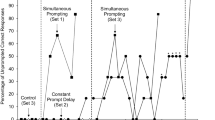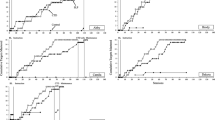Abstract
This study examined the effectiveness of a simultaneous prompting procedure to teach receptive manual sign identification to adults with disabilities in a small group format. A multiple probe design across behaviors evaluated the acquisition of targeted signs by adults attending a day habilitation program. In addition, the investigator collected data on observational learning of nontargeted signs presented to group members. All participants learned to verbally label manual signs modeled by the instructor and showed an increase in the ability to label nontargeted signs.
Similar content being viewed by others
REFERENCES
Alberto, P. A., and Troutman, A. C. (1990). Applied Behavior Analysis for Teachers (3rd Ed.), Macmillan, New York.
Bryen, D. N., Goldman, A. S., and Quinlisk-Gill, S. (1988). Sign language with students with severe/profound mental retardation: How effective is it? Ed. Train. Ment. Retard. 23: 129–137.
Bryen, D., and Joyce, D. (1985). Language intervention with the severely handicapped: A decade of research. J. Sp. Ed. 19: 7–39.
Brown, F., and Snell, M. E. (1993). Measurement, analysis, and evaluation. In Snell, M. E. (ed.), Instruction of Students with Severe Disabilities (4th Ed.), Macmillan, New York.
Collins, B. C., Gast, D. L., Ault, M. J., and Wolery, M. (1991). Small group instruction: Guidelines for teachers of students with moderate to severe handicaps. Ed. Ment. Retard. 26: 18–31.
Farmer, J. A., Gast, D. L., Wolery, M., and Winterling, V. (1991). Small group instruction for students with severe handicaps: A study of observational learning. Ed. Train. Ment. Retard. 26: 190–201.
Gibson, A. M., and Schuster, J. W. (1992). The use of simultaneous prompting for teaching expressive word recognition to preschool children. Top. Early Child. Sp. Ed. 12: 247–267.
Goldstein, H., and Hockenberger, E. H. (1991). Significant progress in child language intervention: An 11-year retrospect. Res. Devel. Dis. 12: 401–424.
Griffen, A. K., Wolery, M., and Schuster, J. W. (1992). Triadic instruction of chained food preparation responses: Acquisition and observational learning. J. Appl. Behav. Anal. 25: 193–204.
Keel, M. C., and Gast, D. L. (1992). Small group instruction for students with learning disabilities: Observational and incidental learning. Except. Child. 58: 357–368.
Kleinert, H. L., and Gast, D. L. (1982). Teaching a multihandicapped adult manual signs using a constant time delay procedure. J. Assoc. Severe. Handicapped 6: 25–32.
Layton, T. L., and Baker, P. S. (1981). Description of semantic-syntactic relations in an autistic child. J. Aut. Devel. Dis. 11: 385–399.
Lieberth, A., K., and Gamble, M. E. B. (1991). The role of iconicity in sign language learning by hearing adults. J. Commun. Dis. 24: 89–99.
MacFarland-Smith, J., Schuster, J. W., and Stevens, K. B. (1993). Using simultaneous prompting to teach expressive object identification to preschoolers with developmental delays. J. Early Interven. 17: 50–60.
Romer, L. T., Cullinan, T., and Schoenberg, B. (1994). General case training of requesting: A demonstration and analysis. J. Early Interven. 17: 50–60.
Schuster, J. W., and Griffen, A. K. (1993). Teaching a chained task with a simultaneous prompting procedure. J. Behav. Ed. 3: 299–315.
Schuster, J. W., Griffen, A. K., and Wolery, M. (1991). Comparison of simultaneous prompting and constant time delay procedures in teaching sight words to elementary students with moderate mental retardation. J. Behav. Ed. 2: 305–326.
Shelton, B. S., Gast, D. L., Wolery, M., and Winterling, V. (1991). The role of small group instruction in facilitating observational and incidental learning. Lang. Speech Hear. Serv. Schools 22: 123–133.
Sisson, L. A., and Barrett, R. P. (1984). An alternating treatments comparison of oral and total communication training with minimally verbal retarded children. J. Appl. Behav. Anal. 17: 559–566.
Wechsler, D. (1974). Manual for the Wechsler Adult Intelligence Scale—Revised, The Psychological Corporation, New York.
Wolery, M., Ault, M. J., and Doyle, P. M. (1992). Teaching Students with Moderate and Severe Disabilities: Use of Response Prompting Strategies, Longman, White Plains, NY.
Wolery, M., Bailey, D. B., and Sugai, G. E. (1988). Effective Teaching: Principles and Procedures of Applied Behavior Analysis with Exceptional Students, Allyn and Bacon, Needham, MA.
Wolery, M., Holcombe, A., Werts, M. G., and Cipolloni, R. M. (1993). Effects of simultaneous prompting and instructive feedback. Early Ed. Devel. 4: 20–31.
Author information
Authors and Affiliations
Rights and permissions
About this article
Cite this article
Palmer, T., Collins, B.C. & Schuster, J.W. The Use of a Simultaneous Prompting Procedure To Teach Receptive Manual Sign Identification to Adults with Disabilities. Journal of Developmental and Physical Disabilities 11, 179–191 (1999). https://doi.org/10.1023/A:1021851205489
Issue Date:
DOI: https://doi.org/10.1023/A:1021851205489




